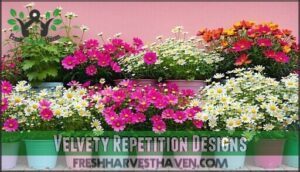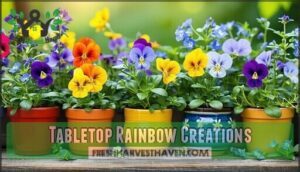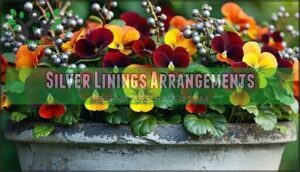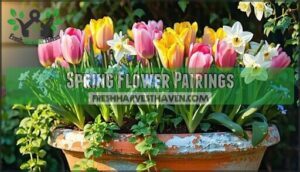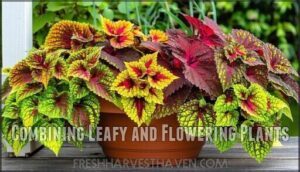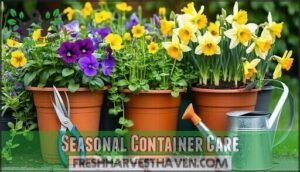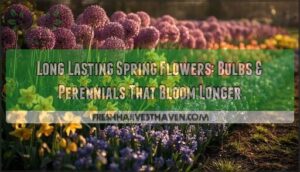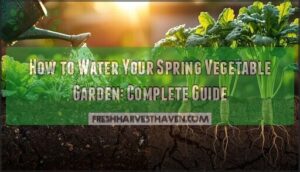This site is supported by our readers. We may earn a commission, at no cost to you, if you purchase through links.
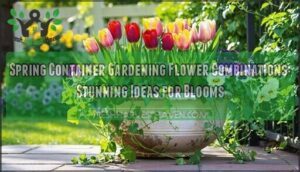 You’ll master spring container gardening flower combinations by using the "thriller, filler, spiller" method.
You’ll master spring container gardening flower combinations by using the "thriller, filler, spiller" method.
Start with upright bloomers like tulips or hyacinths as your thriller, add mid-height pansies or primrose for filler, then cascade trailing ivy or bacopa as spillers.
Cool-season favorites like violas, snapdragons, and sweet alyssum thrive in spring’s unpredictable weather.
Mix textures by pairing delicate flowers with bold foliage plants like dusty miller or ornamental kale.
Choose containers with proper drainage and group odd numbers of plants for natural appeal.
The secret lies in selecting plants that bloom at different times, creating a container that evolves beautifully throughout the season.
Table Of Contents
- Key Takeaways
- Spring Container Basics
- Colorful Spring Combinations
- Spring Flower Pairings
- Texture and Layering
- Seasonal Container Care
- Frequently Asked Questions (FAQs)
- What flowers look good together in pots?
- What is the best mix for container gardening?
- What is the most common mistake made with container plants?
- What to put in planters in spring?
- How do I attract pollinators to spring containers?
- What are pet-safe spring flowers for containers?
- Can spring containers thrive in partial shade?
- How to prevent pests in spring container gardens?
- When should I start planting spring container flowers?
- Conclusion
Key Takeaways
- Use the "thriller, filler, spiller" method by placing upright bloomers like tulips as your centerpiece, adding mid-height pansies for fullness, then cascading trailing plants like ivy for overflow appeal.
- Choose cool-season flowers like violas, snapdragons, and sweet alyssum that’ll handle spring’s unpredictable weather while mixing textures with bold foliage plants like dusty miller.
- Select containers with proper drainage and plant in odd numbers for natural appeal, using quality potting soil and spacing plants correctly for healthy root development.
- Keep your displays fresh by deadheading spent blooms regularly and choosing plants that bloom at different times so your containers evolve beautifully throughout the season.
Spring Container Basics
You’ll want to start with the right containers, good soil, and proper drainage to give your spring flowers a strong foundation.
Think of it as setting up a comfy home—nobody likes soggy feet, not even your plants!
Your plants crave good drainage just like you crave a cozy spot to relax!
Choosing Right Containers
In the context of spring container gardening, picking the right pot is half the fun.
Here’s what you need to know for blooming success:
- Container Material: Go for sturdy, weatherproof options.
- Size Matters: Choose a pot big enough for roots to stretch.
- Drainage Solutions: Make certain holes prevent soggy disasters.
- Aesthetic Appeal: Match your style and budget considerations.
Consider exploring various container garden planters for diverse options.
Soil and Drainage Requirements
After picking your container, focus on soil composition and drainage solutions.
Always use light, fluffy potting soil for healthy plant growth—no backyard dirt allowed.
Make sure your container material has drainage holes to avoid soggy roots.
Proper drainage is essential to prevent root rot.
Practice smart watering techniques and regular plant fertilization for best results.
Remember, good plant drainage and fertilization needs are the backbone of successful container gardening tips, which require proper care.
Selecting Spring Flowers
Every spring, you face a garden full of choices—so let’s make it easy.
Think about bloom timing, sunlight needs, and fragrance profiles when choosing spring container flowers.
Go for regional varieties that thrive in your area, and mix flowers with different symbolism for extra meaning.
The best spring flowers, like pansies or muscari, turn spring flower pots into colorful spring containers worth bragging about.
Colorful Spring Combinations
You can turn any container into a showstopper by mixing bold colors and playful textures, even if your thumb isn’t the greenest.
With the right combinations, your spring flowers will look so lively that even your neighbor’s cat might stop by for a closer look at the bold colors.
Velvety Repetition Designs
After picking the perfect pot, let’s talk velvety repetition designs.
Plant repetition is your friend—using daisy varieties in fuchsia, pink, and white creates a soothing pattern.
Pair with forget-me-nots for texture contrast and white accents that pop.
These flower combinations spring to life in colorful spring containers and make your spring flower pots feel thoughtfully curated.
- Fuchsia pairings with daisies
- Repetition benefits for calm design
- Texture contrast using forget-me-nots
- White accents for a crisp finish
Tabletop Rainbow Creations
While single-color schemes create elegance, you’ll find that mixing miniature snapdragons in warm color palettes with multicolored pansy varieties creates stunning tabletop displays.
These spring container recipes work perfectly in compact spaces, letting you enjoy vibrant flower combinations spring brings without overwhelming your dining area.
You can also consider seasonal plant arrangements for a display that lasts all year.
| Plant Type | Colors Available |
|---|---|
| Miniature Snapdragons | Red, orange, yellow, pink |
| Pansy Varieties | Purple, blue, white, yellow |
| Forget-Me-Nots | Blue, pink, white |
| Supporting Foliage | Green sweet potato vine, parsley |
Choose smaller container sizes for easy repositioning during meals or gatherings.
Silver Linings Arrangements
Silver-toned snowberry varieties create stunning backdrop magic when you pair them with burgundy and orange violas.
This multi-seasonal appeal means your spring container recipes evolve beautifully into summer.
Lavender care stays simple—just deadhead spent blooms.
These sophisticated spring flower arrangements prove that container arrangements don’t need bright colors to make bold statements in your spring gardening ideas, with simple care like lavender.
Spring Flower Pairings
You’ll discover that strategic flower pairings create the most stunning spring containers when you match complementary textures and colors.
These three classic combinations offer foolproof ways to achieve professional-looking results that’ll make your neighbors peek over the fence.
Muscari and Moss Combinations
Beyond basic spring container gardening arrangements, muscari varieties paired with different moss types create stunning color contrasts that’ll make your neighbors stop and stare.
These plant combinations work perfectly in smaller containers, offering natural woodland charm.
- Dense blue muscari spikes emerge through soft green moss cushions for striking visual depth
- Moss acts as living mulch that keeps soil moist while preventing bulb rot in container planting
- Extended bloom time occurs when moss insulates muscari crowns, adding four extra days of spring blooms
Choose well-draining containers since muscari needs good drainage while moss requires consistent moisture.
To maximize blooms, provide six hours of sunlight daily.
Weekly misting keeps moss vibrant, and light spring feeding helps muscari thrive without getting floppy.
Violas and English Ivy Pairings
Combine violas with English ivy for foolproof spring container gardening success.
Choose burgundy or orange viola colors against ivy’s green backdrop for stunning contrast. These hardy plant combinations thrive in partial shade with minimal fuss.
Select 12-inch containers minimum for proper root development. You can find various Violas English Ivy products online.
Both boast excellent winter hardiness, making them perfect low-maintenance spring blooms that’ll bounce back season after season.
Pansies and Seasonal Flowers
Pansies shine as spring container gardening stars, with over 300 pansy varieties offering endless flower colors from deep purples to sunny yellows.
These compact beauties pair perfectly with companion plants like daffodils and tulips, creating layered spring garden design magic.
Choose containers at least 25cm deep for healthy roots, and give your spring flowers six hours of sun exposure.
Plant combinations for spring work best when you space pansies 8-15cm apart—they’ll reward you with blooms even when temperatures hit 7°C, making them excellent for spring container gardening with companion plants like daffodils.
Texture and Layering
You’ll create stunning spring containers by mixing different plant textures and heights for visual depth.
Layer leafy perennials with flowering annuals and add trailing plants to build a garden that catches the eye from every angle, creating a beautiful display of texture.
Combining Leafy and Flowering Plants
Texture harmony becomes your secret weapon when you mix leafy and flowering plants in spring containers.
Foliage contrast from coleus paired with calibrachoa creates visual drama, while their complementary growth habits guarantee neither overpowers the other.
Time your bloom timing so flowers emerge as foliage matures, creating color echoes throughout the season.
Using Heat-Tolerant Annuals
Smart annual selection transforms spring containers into resilient showstoppers that’ll thrive when temperatures climb.
Transform ordinary pots into garden gold with the right heat-loving plants that laugh at summer’s scorching temper.
Heat-tolerant varieties like lantana, celosia, and vinca handle sun exposure beautifully while maintaining vibrant bloom times through challenging weather.
Here’s your go-to lineup for sunny container plants:
- Lantana – tolerates soil temperature spikes, needs minimal watering
- Celosia – maintains color during heat waves, perfect for container garden ideas
- Vinca – handles 80% direct sunlight, drought-resistant champion
- Angelonia – continuous blooming despite temperature stress, ideal for summer annuals
These workhorses bridge spring container gardening into summer seamlessly, creating stunning flower combinations that won’t wilt when the heat’s on.
Layering Plants for Interest
Creating visual depth in your spring container gardening starts with smart layering techniques.
Place tall ornamental grasses or upright plants in back for Height Considerations, add mounding flowers like coleus in middle for Color Harmony, then finish with trailing creeping Jenny for Texture Contrast.
Consider Bloom Times when selecting plant combinations – early spring bulbs pair beautifully with late-blooming perennials.
Proper Plant Spacing guarantees each layer shines in your container arrangements.
It’s also helpful to test soil pH for superior plant health.
Seasonal Container Care
Your spring containers will flourish with proper care that keeps plants healthy and blooming strong throughout the season.
Smart maintenance habits like deadheading spent flowers and swapping out tired plants will keep your displays looking fresh from early spring through summer’s arrival, utilizing proper care to maintain their appearance.
Deadheading and Maintenance
Your spring flowers will thrive with regular deadheading—simply pinch off spent blooms to encourage continuous flowering throughout the season.
This essential garden maintenance technique, combined with consistent watering needs and a proper fertilizing schedule, keeps your container gardening displays looking fresh.
Consider using specialized garden tools for best results.
Monitor for pest control issues while pruning techniques help maintain plant support and shape in your spring container gardening setup.
Adapting to Seasonal Changes
Your garden’s personality shifts as seasons evolve, and you’ll need to roll with these natural changes.
Spring container gardening means embracing plant succession while managing weather challenges and adjusting care routines. Here’s how to keep your seasonal plant arrangements thriving:
- Replace dying spring annuals containers with heat-tolerant summer varieties as temperatures rise
- Adjust watering needs from weekly to daily as plants grow and weather warms
- Monitor for pest management issues that emerge with changing conditions
- Add soil enrichment through regular fertilizing as nutrients deplete over time
As you move to fall, consider how deadheading encourages blooms for a longer lasting display.
Choosing Healthy and In-Season Plants
Your spring container gardening success starts with smart plant inspection at local nurseries. Look for firm stems, vibrant leaves, and white roots that aren’t circling the pot’s bottom.
Choose spring annuals containers during peak availability—late February through April—when disease resistance is highest. Allow an acclimation period after purchase, providing temporary shade before planting.
Healthy spring bulbs and pest control-ready plants guarantee your spring colour displays thrive beautifully.
Frequently Asked Questions (FAQs)
What flowers look good together in pots?
You’ll love pairing bright pansies with delicate forget-me-nots for spring charm.
Try mixing snapdragons in warm tones with colorful violas, or combine fragrant lavender with burgundy pansies and silvery foliage for stunning contrast.
What is the best mix for container gardening?
Research shows 80% of container gardens fail due to poor plant combinations.
You’ll want quality soilless mix with drainage holes, then combine "thriller, filler, spiller" plants like cordyline, coleus, and creeping Jenny for stunning results.
What is the most common mistake made with container plants?
You’re probably drowning your plants with too much water or starving them with too little.
Most container gardeners either overwater until roots rot or underwater until leaves wilt—finding that sweet spot takes practice.
What to put in planters in spring?
Think of spring planters as nature’s fresh canvas awaiting your artistic touch. You’ll want cool-season champions like pansies, violas, and forget-me-nots that thrive in spring’s unpredictable weather, creating colorful displays.
How do I attract pollinators to spring containers?
Plant native wildflowers like forget-me-nots, violas, and pansies in your containers. These blooms naturally attract bees, butterflies, and hoverflies while providing nectar throughout spring’s changing weather patterns.
What are pet-safe spring flowers for containers?
Your furry friends can safely enjoy snapdragons, dahlias, marigolds, and petunias in your spring containers. African violets and calendulas also won’t harm curious pets who nibble your blooms.
Can spring containers thrive in partial shade?
Absolutely, you’ll find success with shade-loving beauties like impatiens, begonias, and caladiums.
These resilient performers actually prefer filtered light, creating lush displays while dodging harsh afternoon sun that wilts their delicate petals.
How to prevent pests in spring container gardens?
Keep containers healthy by choosing well-draining pots and quality potting mix.
Check plants weekly for aphids, spider mites, or slugs.
Use insecticidal soap for soft-bodied pests and remove slugs by hand during evening checks.
When should I start planting spring container flowers?
When’s the best time to beat the spring frost and get your colorful blooms going?
Start your spring container flowers 2-4 weeks after your area’s last frost date, when nighttime temperatures stay above 45°F consistently.
Conclusion
Mastering spring container gardening flower combinations is like painting with living colors that change throughout the season.
You’ve learned the thriller-filler-spiller method, discovered cool-season champions, and explored texture combinations that’ll make your neighbors green with envy.
Remember to deadhead spent blooms, adjust for weather changes, and choose plants that peak at different times.
Your containers will transform from simple planters into dynamic displays that evolve beautifully, with proper drainage, strategic plant placement, and these proven spring container gardening flower combinations, you’ll create stunning displays.
- https://www.ruralsprout.com/anise-hyssop/
- https://www.pinterest.com/jennygirlgainer/pins/
- https://www.bloomingbackyard.com/plant-combinations-for-containers/
- https://www.annsentitledlife.com/how-does-your-garden-grow/how-to-make-a-rainbow-flower-container-garden/
- https://www.calloways.com/blog/how-to-grow-a-rainbow-garden/

